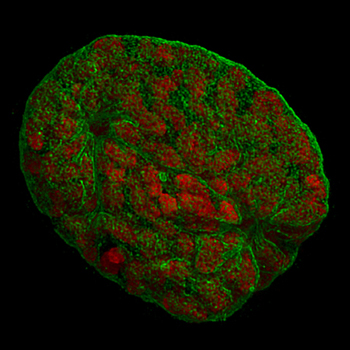Video of the Week—A New Dimension to Light Microscopy
Quick Links
Traditional microscopy has always had its limitations. The maximum resolution achievable is about half the wavelength of light used, or 200 to 350 nanometers. But in tomorrow’s Science, researchers in Germany and the U.S. debut a new type of light microscopy, one that not only resolves objects as close as 100 nanometers, but also renders them in beautiful multicolored 3D images. Called three-dimensional structured illumination microscopy (3D-SIM), the technique can be applied to a variety of subcellular structures and reveals features that are missed by conventional light microscopes.
Researchers led by Heinrich Leonhardt at the Ludwig Maximillians University, Munich, Germany, and John Sedat at the University of California, San Francisco, developed the technique. Ironically, 3D-SIM is based on the very property that limits traditional light microscopy—diffraction. The sample is illuminated with three beams of interfering laser light that form a pattern along three planes. The light emitted from the sample forms a complex figure that can be de-convoluted computationally to reveal structural information. No special preparation of the sample is needed.
The researchers trained their new microscope on C2C12 mouse myoblast cell nuclei. 3D-SIM revealed single nuclear pore complexes (see figure and related movie below) and double-layered invaginations of the nuclear envelope in prophase—the latter have only been seen in the electron microscope.

Nucleus in 3D
This 3D-SIM projection of a mouse C2C12 nucleus at prophase shows chromosomes stained with DAPI (red), surrounded by lamin B immunoreactivy (green) in the nuclear envelope. The chromosomes, visible in high detail, are condensed and the nuclear envelope is visibly distorted and punctured by the forming mitotic spindle. The video shows the fine structure in greater detail. Image and video credit: Lothar Schermelleh, and Peter Carlton
Though the resolution of 3D-SIM is not as good as achieved by some other recent light microscopy advances such as stimulated emission depletion (STED), which can get down to about 45 nanometer resolution (see ARF related news story), “3D-SIM is currently the only subdiffraction-resolution imaging technique that can produce multicolor 3D images of whole cells with enhancement of resolution in both lateral and axial directions,” write the authors. In an interview with ARF, Sedat noted that a major advantage of 3D-SIM is that it is up to 50 times faster than other light-based techniques and is perfectly suited to capturing images in living cells. “This opens a lot of arenas,” suggested Sedat. “The live information is really where all the biology is, and though a lot of people collect live data, albeit slowly, under conditions where there are so many photons, the light is so intense that it basically damages the cell. We can go many orders of magnitude lower [in intensity],” he said.—Tom Fagan
References
News Citations
Other Citations
Further Reading
Primary Papers
- Schermelleh L, Carlton PM, Haase S, Shao L, Winoto L, Kner P, Burke B, Cardoso MC, Agard DA, Gustafsson MG, Leonhardt H, Sedat JW. Subdiffraction multicolor imaging of the nuclear periphery with 3D structured illumination microscopy. Science. 2008 Jun 6;320(5881):1332-6. PubMed.
Annotate
To make an annotation you must Login or Register.

Comments
No Available Comments
Make a Comment
To make a comment you must login or register.